Glaucoma is a group of eye diseases characterised by progressive optic neuropathy with visual field loss. In Africa, it is a serious and irreversibly blinding eye condition of public health importance, with a prevalence of about 4% in people aged 40 years and above.
Glaucoma affects all ages, but the risk increases with increasing age, and genetics also play a role in its development.
There is an interplay between raised intraocular pressure (IOP) and ocular anatomical structures such as corneal thickness, corneal hysteresis, optic nerve head size, ocular blood flow dynamics and intracranial pressure.
In 85% of those affected in Nigeria, glaucoma is open-angle glaucoma (OAG) where the absence of distinct early symptoms makes the condition hard to notice. As such, people with glaucoma often present at the hospital with advanced disease, with about 90% already blind in one eye.
Vision impairment in glaucoma cannot be cured but can be prevented if detected early and appropriate effective treatment is instituted. These include medical treatment, surgical interventions, and laser therapies. Glaucoma is a complex disease to manage, and ophthalmologists face many constraints in managing it.
Access to quality eye care is noted as a significant risk factor for glaucoma blindness, which can result from a lack of treatment or poor treatment outcomes. It is essential that when eye care service providers make a timely diagnosis of glaucoma, they are resolute in their line of management.

